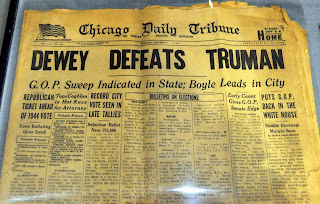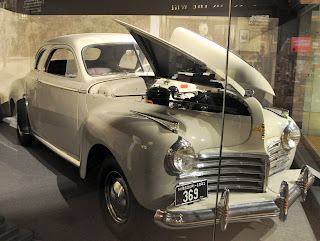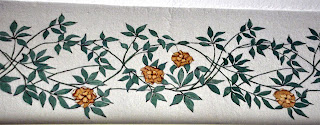The First Floor of the Library is dedicated to Truman the President. Truman was a President that came into the office with the least experience, yet he dealt with a vast array of serious issues. Few presidential acts have ignited as much controversy as his decision to use atomic weapons against Japan. Throughout the museum were journal books for visitors to leave their views on the controversial subjects Truman addressed and it was interesting to read comments from an array of visitors including Japanese visitors, Pearl Harbor affected family members and also retired military. There were also various video theaters throughout the first floor where thought-provoking questions were asked and each seat had its own voting buttons with audience votes being tallied and shared on the screen.
Following World War II Truman dealt with double-digit inflation. He advocated reconversion and also several progressive ideas. He tried to guarantee full employment, raise the minimum wage by 50 percent, expand Social Security Benefits, ban racial discrimination in employment, clear the slums and build better housing. He even added national health insurance to his plan that he called the ‘Fair Deal’. But his progressive proposals were mostly shot down by a Conservative Congress. And when inflation hit, as so often happens today, the President got the blame, not the Congress that mostly called the shots.
In 1948 he was the first President and also made the US the first nation to recognize the state of Israel, a decision that remains controversial today. Truman was instrumental in containing communism in both Europe and Asia and ordered the airlifts of food and supplies to West Berlin during the Berlin Blockade. During the Truman years, the US/Russia arms race began. Truman is credited with starting the Dept. of Defense, the CIA, Atomic Energy Commission, and the National Security Council. He was also responsible for desegregating the military.
By waging war in Korea without a congressional declaration, he set a precedent for future presidents. He was criticized by many for the Korean War that claimed the lives of over 54,000 Americans. Truman received several bitter letters from parents who had lost their sons in this war. I think it says something about the person Harry Truman, however, that the Museum Staff found in the president’s office desk, one such letter along with the returned Purple Heart of a soldier, George Banning. I can only imagine that the tough decisions of the office weighed heavy on him. For a man that came into office originally with little experience, he ended up having his finger in so many things that are the foundation of our Nation and its issues today. The first floor of this museum does an excellent job of honestly presenting the various factors that Truman struggled with regarding the difficult decisions that he made. Many Presidential Museums somewhat serve as a boasting platform for one's accomplishments while in office. In contrast, we felt that the first floor of the Truman Presidential Museum presented how difficult Truman’s decisions were while imparting a sense of humility for a man that sincerely tried to do what was best for our Nation. Truman faced many hard decisions, some may argue not all were the best decisions, but it seems, for the most part, he attempted to be fully informed and his intentions were driven by doing what was best for the Nation, not necessarily his party. An opinion, I realize. But it is the perception I left the museum with.
The Basement of the Truman Presidential Library is dedicated to Harry Truman’s life prior to being President. Harry was born in the small Missouri town of Lamar on May 8, 1884. He was born with poor eyesight and required glasses. His poor eyesight channeled him away from sports and towards books and music.
He was an accomplished piano player and even considered a career as a concert pianist at one point. The family was poor which prevented Harry from attending a 4-year college. He attended a business college for a semester but the family’s finances became dire, necessitating that Harry drops out of college and get a job to help with the family finances. He worked as a bank clerk for a while but would later leave that job to help out on the family farm in Grandview, Missouri. In 1905 Harry joined the National Guard. In 1910 he began courting Bess Wallace whom he had graduated from high school with. She came from a family with money and Harry felt he needed to be more than a farmer in order to win her hand in marriage.
He made many attempts to make money including owning and operating a mining business and also being a partner in an oil business. Neither was meet with much success. In 1917, he rejoined his National Guard unit and he was soon off to World War I where he rose to the rank of captain. His service in World War I had a profound effect on his life and also developed his self-confidence as well as his leadership skills.
On his return home, Harry married his lifelong sweetheart Bess. Four years later they had their first and only child, Mary Margaret. A few months after returning home from the war, Harry and his war buddy Eddie Jacobson opened a haberdashery. The store financially failed and left Harry nearly bankrupt. Even though it financially failed he became a respected businessman in the community which would later serve him well in his political endeavors.
In 1922, Thomas Pendergast, the Democratic boss of Kansas City asked Harry to run for a judgeship on the county court. With the backing of Pendergast’s money, Harry won that judgeship. Fast forward to 1934 and Harry is off to Washington, D.C. as Senator-elect.
In Washington, he emerged as a reliable ally of President Franklin D. Roosevelts’ ‘New Deal’ programs. In 1944, President Roosevelt decided to drop Wallace, his sitting Vice President from the ticket. After a set of complicated behind the scenes maneuvers by the Democratic Party, Harry Truman surprisingly emerged as the vice presidential nominee.
After only serving 82 days as the Vice President of the United States, President Roosevelt’s death would suddenly plunge Harry right into becoming our nation’s 33rd President of the United States.
The Basement of the Truman Presidential Library contains much memorabilia from Harry’s childhood, family, and various career attempts and also love letters he sent to Bess. Bess was his lifelong love, friend and advisor. The museum does a good job of representing her importance to him. On this floor are also several interactive exhibits for the younger visitors.
We went by the Harry and Bess Truman family home. The home was built by Bess’s grandfather and it would be the family home for Harry and Bess from marriage until their deaths. The home is open to tours but sadly was not open the day we were in Independence.
While in Independence we also toured the Bingham-Waggoner Estate. Hoping to make a living by supplying the wagon trains, John Lewis, a saddle maker built his six-room house along a shortcut of what would later come to be known as the Santa Fe Trail. Just prior to the Civil War breaking out Lewis sold the house to John Caleb Bingham, an American artist. Bingham maintained a studio at this residence. In 1868 Bingham became a candidate for Congress but was defeated. Bingham would later become a very well know artist and his works are displayed throughout the museum portion.
The Waggoneers were early flour millers in Pennsylvania. Looking for new milling opportunities, in 1867 Peter Waggoner Sr. bought the old City Mill (directly next to this house) and also purchased this home from Bingham. The company was known for producing the very best in baking and cake flours. They coined the name ‘Queen of the Pantry’ and these flours became well known in the mid-west. At somepoint Waggoneer took on a business partner, Gates. Gates was the maternal grandfather of Bess Truman, Harry Truman's wife. The Waggoner family continued to live in the home until 1976. During their stay, they would expand the six-room home to 26 rooms and three stories. Upon the death of the last Waggoneer, because there were no heirs, the house was left to the housekeeper’s children. The house was sold to the foundation for approximately $500,000, but the true gem was all the original furnishing were still within the home upon purchase. It is a beautiful home with many treasures. The last set of pictures show the room borders in the various rooms. Each room had its own unique border and we have included a few of them close up in this blog.
Leaving the estate, a few blocks away, we drove by the courthouse where Harry Truman had his first judgeship. And of course, we had to have BBQ for it is Missouri after all. And the results are in......Missouri has the best BBQ I have had to date.
Leaving the estate, a few blocks away, we drove by the courthouse where Harry Truman had his first judgeship. And of course, we had to have BBQ for it is Missouri after all. And the results are in......Missouri has the best BBQ I have had to date.





































No comments:
Post a Comment